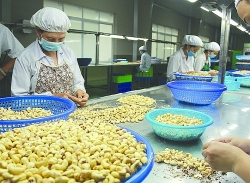 |
| With many agricultural and aquatic products, Vietnam has advantages when exporting to new markets. Photo: N.Thanh |
New records
According to statistics, in the first 11 months of 2022, many items have been opened to difficult markets such as Japan, the US, etc., signalling optimism in the coming time. Specifically, in 2022, the Ministry of Agriculture and Rural Development and the General Administration of Customs of China successively signed protocols to officially export many types of fruits and foods to China, such as passion fruit, bananas, durian, sweet potato, bird’s nest, etc. Recently, the US has officially opened the door for Vietnam’s pomelo; Longan and macadamia nuts are also allowed to be exported by Japan; New Zealand opened the door to Vietnam’s green lemons; Meanwhile, many kinds of high-quality Vietnamese rice have appeared in supermarkets of the US, EU, Japan, etc.
The results in the market opening have contributed to helping Vietnam’s agricultural, forestry, and fishery exports in the first 11 months of 2022 reach about 49.04 billion USD, up 11.8% over the same period in 2021, of which export of primary agricultural products is over 20.73 billion USD, up 6.6%; main forest products about 15.59 billion USD, up 8.2%; seafood reached 10.14 billion USD, up 27%. Up to now, there have been 8 products/product groups with an export value of over 2 billion USD (coffee, rubber, rice, vegetables, cashew, shrimp, pangasius, and wooden products).
Sharing the picture of Vietnam’s agricultural market in 2022, Dao The Anh, Deputy Director of the Vietnam Academy of Agricultural Sciences, said that we depended a lot on the Chinese market in the past. However, in 2022, China will implement the “Zero Covid” policy, shifting to safe products and stricter quality control of agricultural products. This is both a difficulty and a motivation for Vietnamese enterprises to change production methods drastically. In particular, the fruit and vegetable industry has opened up a series of planting codes for export to China. This is considered a great achievement and is the first result in the next 10 years of the transition to ecological, sustainable and transparent karma.
Telling more about the process of opening up new markets, Nguyen Quang Hieu, Head of the Department of International Cooperation and Communication (Department of Plant Protection, Ministry of Agriculture and Rural Development), said to open up the market, the market for an agricultural product, it takes us 3-5 years, before it took us decades to open the door for an agricultural product. “We identify China as the main market of Vietnam’s fruit export industry, but after many years of pursuing the strategy of developing countries, affirming the value and brand of Vietnamese agricultural products, we have an export market for agricultural products. For example, we choose Korea as one of our strategic markets because when we succeed with the Korean market, we will go to half of the Japanese market. Therefore, shortly, we will export longan to Japan. To prepare for the longan to export to Japan, we have started trade promotion and prepared preparation procedures from 2016-2020. Besides, it took us 1.5 years to test products that meet Japanese requirements,” added Hieu.
To promote agricultural exports in 2023, Nguyen Quang Hieu said that the Chinese market is still very important for Vietnam’s fruit export industry. However, this year, the US has climbed to first place, so in 2023, it is expected to bring passion fruit and pineapple into this market, which also gives people the opportunity to increase the economic value of the product. Besides, it will continue negotiating and promoting bringing pomelos to the Chinese market. Therefore, businesses must actively build material areas and brands for their products. In addition, the timely entry of trade promotion is also a factor in “breaking the market better” for Vietnamese agricultural products to penetrate large markets.
Reorganize production according to the signal of the market
However, in the opinion of experts, opening the market is difficult, but keeping the market and developing sustainably is even more difficult, requiring each farmer and business to change their production thinking to meet the requirements and standards of each market. Ngo Tuong Vy, General Director of Chanh Thu Fruit Import-Export Group Joint Stock Company, emphasized that opening a market takes at least 3 to 5 years. For example, when businesses bring some products for export, it takes up to 6 years to enter the US… Therefore, the results from the market opening in the past time are great efforts from the agencies of the Ministry of Agriculture and Rural Development in negotiating to open the market. However, when we opened the market, the critical issue was how to maintain and develop that market. This is not only the duty of enterprises but also the role of localities and farmers in the linkage chain.
Agreeing with this view, Ngo Xuan Nam, Deputy Director of the National Office of Notification and Inquiry on Sanitation, Epidemiology and Quarantine of Vietnam Animals and Plants (SPS Vietnam Office, Ministry of Agriculture and Development) To open the market, it is necessary to strengthen links not only with farmers but also between industries and businesses. In addition, up to now, Vietnam has signed 18 free trade agreements, many of which are associated with major markets such as the US and the European Union.
 | Cambodian agricultural products “land” in Vietnam market VCN – In the past few years, many Cambodian agricultural products have massively “landed” into the Vietnamese … |
Nam also affirmed that if we diversify the market, we must also reorganize production according to the signal of the market. Practice requires alignment. In addition to linking farmer households together, farmer households must be linked with local and central management agencies. For example, exporting products of plant origin is required to cooperate with the Plant Protection Department. This is a very close companion of state management agencies with farmers and businesses.
